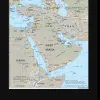Take a look inside 4 images
The World Factbook for iPad
Pros: Data, metadata, and details galore about countries around the world.
Cons: With no pretty design or presentation, it lacks engagement -- just the facts, ma'am probably won't be enough for all kids.
Bottom Line: Kids can easily use legit CIA data in their research projects, but presentation-wise, it's not too exciting.
Put this app in kids' hands for research projects, and use the Comparisons section as an example of ways to present information graphically as well as to teach kids to draw conclusions from data. Maps are easily accessible and can be used in whole class discussions, with small groups, or individuals. You can let kids explore on their own to research a project of their choice, or, probably more effectively, assign a topic and see how kids do with researching here.
The World Factbook for iPad is a reference app compiled by the CIA providing info on all the world's countries. Choose a country on the left side of the screen and read the profile info on the right. You'll see all kinds of data organized into nine categories: introduction, geography, people, government, economy, communications, transportation, military, and transnational issues. Whew! Use the Comparisons feature to view individual subsets of data for all countries; for example, the birthrate for all countries from highest to lowest. Maps are also a big part of the site, including global regions as well as individual countries.
It does a fine job presenting the CIA's remarkable database of information in a mobile format, but fine is the operative word here. The good: It's a gold mine for research, and all info lives in the app, so you can access it offline too. Curious kids could spend hours reading about global history, government, health care, and transportation systems –- and they would've only scratched the surface of this impressive database.
Not-so-good: there's not much engagement for younger users. The heavily text-based design is okay for self-motivated kids (especially the ones who like thumbing through the dictionary or reading Wikipedia for fun), but without a specific assignment or goal, kids may not have an incentive to dig too deeply here. Also, not all data is necessarily current; be sure to check when things were most recently updated. If the site were more interactive, guiding kids to build concepts or recognize patterns about key cultural, geographic, and political phenomena, they could connect with this great info in a more powerful way.










